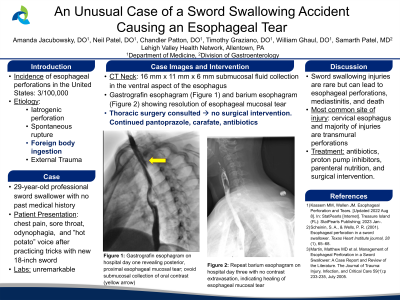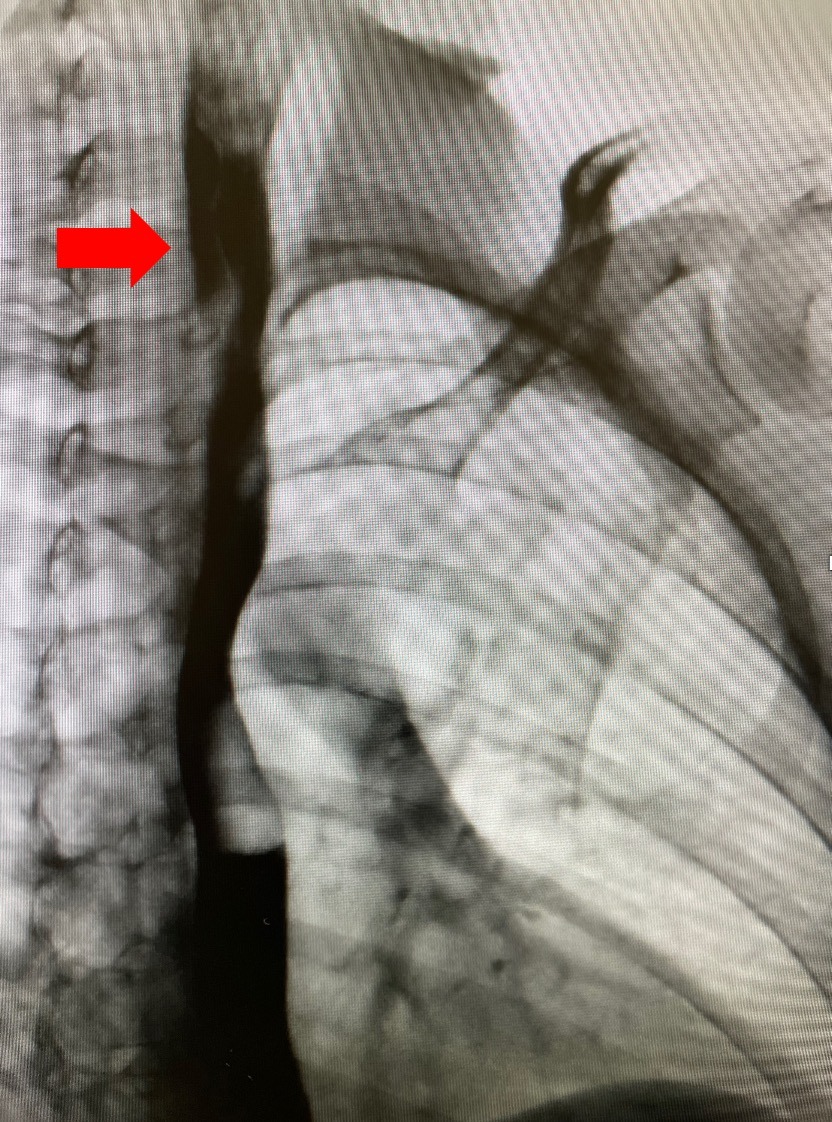Sunday Poster Session
Category: Esophagus
P0495 - An Unusual Case of a Sword Swallowing Accident Causing an Esophageal Tear
Sunday, October 22, 2023
3:30 PM - 7:00 PM PT
Location: Exhibit Hall

Has Audio

Amanda Jacubowsky, DO, MSMEd
Lehigh Valley Health Network
Allentown, PA
Presenting Author(s)
Amanda Jacubowsky, DO, MSMEd, Neil Patel, DO, Chandler Patton, DO, Timothy Graziano, DO, William Ghaul, DO, Samarth Patel, MD
Lehigh Valley Health Network, Allentown, PA
Introduction: Esophageal perforations are rare in the United States, with a frequency of 3 in 100,000. Causes include iatrogenic perforation, spontaneous rupture, foreign body ingestion, and external trauma. Here we present a case of an unusual etiology of an esophageal tear due to a sword-swallowing accident.
Case Description/Methods: A 29-year-old male who is a professional sword swallower presented to the hospital with odynophagia and chest pain that occurred while practicing a trick with a new 18-inch sword. Upon evaluation in the emergency department, he was hemodynamically stable. Initial labs revealed a normal complete blood count and comprehensive metabolic panel. With significant odynophagia, the patient went for a CT scan of his neck which showed a 16 mm x 11 mm x 6 mm submucosal fluid collection in the ventral aspect of the esophagus, concerning for a mucosal tear. To confirm this finding, an esophagram was performed and showed a posterior, proximal esophageal mucosal tear with an ovoid submucosal collection of oral contrast at the area of concern. The patient was started on antibiotics, a proton pump inhibitor, and sucralfate. A thoracic surgery consult was obtained and the decision was made to pursue conservative management for a superficial esophageal mucosal tear. The repeat test showed no persistent intraluminal esophageal filling defect or contrast extravasation.
Discussion: Sword swallowing injuries are a rare but potentially life-threatening occurrence. Previous reports have described esophageal perforations, mediastinitis, and even death resulting from this activity. Injuries can occur due to improper technique, using inappropriate instruments, or performing the stunt under the influence of alcohol or drugs. Studies have reported that the most common site of injury during sword swallowing is the cervical esophagus, with a majority of injuries being transmural perforations. It also has been noted that the most common presenting symptom of esophageal injury in sword swallowers is chest pain, followed by fever, dysphagia, and neck pain. Treatment options for esophageal injuries in sword swallowers include antibiotics, proton pump inhibitors, parenteral nutrition, and surgical intervention.

Disclosures:
Amanda Jacubowsky, DO, MSMEd, Neil Patel, DO, Chandler Patton, DO, Timothy Graziano, DO, William Ghaul, DO, Samarth Patel, MD. P0495 - An Unusual Case of a Sword Swallowing Accident Causing an Esophageal Tear, ACG 2023 Annual Scientific Meeting Abstracts. Vancouver, BC, Canada: American College of Gastroenterology.
Lehigh Valley Health Network, Allentown, PA
Introduction: Esophageal perforations are rare in the United States, with a frequency of 3 in 100,000. Causes include iatrogenic perforation, spontaneous rupture, foreign body ingestion, and external trauma. Here we present a case of an unusual etiology of an esophageal tear due to a sword-swallowing accident.
Case Description/Methods: A 29-year-old male who is a professional sword swallower presented to the hospital with odynophagia and chest pain that occurred while practicing a trick with a new 18-inch sword. Upon evaluation in the emergency department, he was hemodynamically stable. Initial labs revealed a normal complete blood count and comprehensive metabolic panel. With significant odynophagia, the patient went for a CT scan of his neck which showed a 16 mm x 11 mm x 6 mm submucosal fluid collection in the ventral aspect of the esophagus, concerning for a mucosal tear. To confirm this finding, an esophagram was performed and showed a posterior, proximal esophageal mucosal tear with an ovoid submucosal collection of oral contrast at the area of concern. The patient was started on antibiotics, a proton pump inhibitor, and sucralfate. A thoracic surgery consult was obtained and the decision was made to pursue conservative management for a superficial esophageal mucosal tear. The repeat test showed no persistent intraluminal esophageal filling defect or contrast extravasation.
Discussion: Sword swallowing injuries are a rare but potentially life-threatening occurrence. Previous reports have described esophageal perforations, mediastinitis, and even death resulting from this activity. Injuries can occur due to improper technique, using inappropriate instruments, or performing the stunt under the influence of alcohol or drugs. Studies have reported that the most common site of injury during sword swallowing is the cervical esophagus, with a majority of injuries being transmural perforations. It also has been noted that the most common presenting symptom of esophageal injury in sword swallowers is chest pain, followed by fever, dysphagia, and neck pain. Treatment options for esophageal injuries in sword swallowers include antibiotics, proton pump inhibitors, parenteral nutrition, and surgical intervention.

Figure: Esophagram revealing posterior, proximal esophageal mucosal tear with an ovoid submucosal collection of oral contrast
Disclosures:
Amanda Jacubowsky indicated no relevant financial relationships.
Neil Patel indicated no relevant financial relationships.
Chandler Patton indicated no relevant financial relationships.
Timothy Graziano indicated no relevant financial relationships.
William Ghaul indicated no relevant financial relationships.
Samarth Patel indicated no relevant financial relationships.
Amanda Jacubowsky, DO, MSMEd, Neil Patel, DO, Chandler Patton, DO, Timothy Graziano, DO, William Ghaul, DO, Samarth Patel, MD. P0495 - An Unusual Case of a Sword Swallowing Accident Causing an Esophageal Tear, ACG 2023 Annual Scientific Meeting Abstracts. Vancouver, BC, Canada: American College of Gastroenterology.
